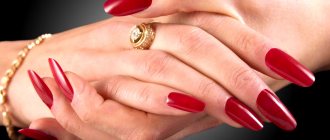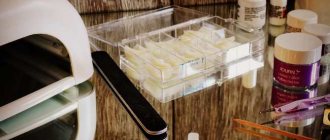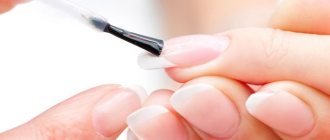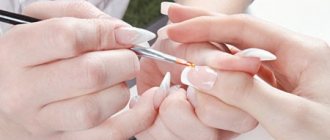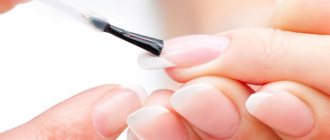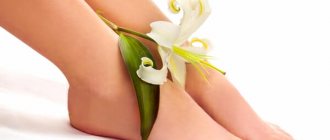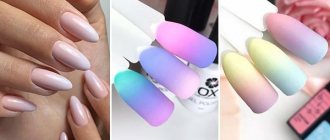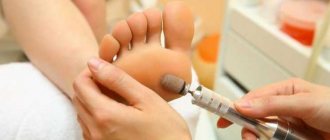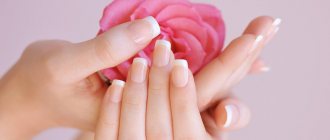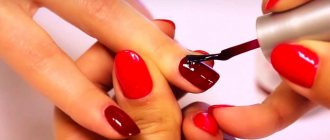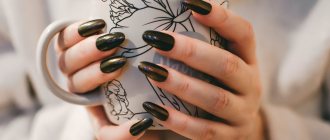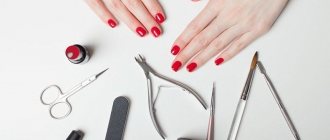This is a short guide for those who, for one reason or another, decided to do their own manicure. It's not that difficult if you approach it wisely. Read and get started...
To keep your hands and nails always looking well-groomed, you need to get a manicure about once a week. This procedure can be performed by a master in a beauty salon - quickly and accurately.
But some people don’t have the opportunity to do a manicure in a salon, while others have the time and desire. We recommend learning how to do a manicure at home yourself. With a little practice, your nails will look like you regularly visit a beauty salon!
I want to become a manicurist. Where to begin?
Manicure, like any other occupation, requires constant improvement and training, dedication and discipline. Many girls living their dreams take courses and even open a beauty salon at home, which ceases to exist after a maximum of a year and this is in 90% of cases. It's time to take off your rose-colored glasses and make sure that you really want to become a master, working 10 hours a day, at least until you get the hang of it and acquire a large client base to maintain a stable financial condition of the studio.
Becoming a good manicurist is not as easy as you think. And becoming the best of the best is a feasible task, but it requires complete dedication. First of all, decide whether you really need this specialty. In order to put everything into perspective, ProstoNail has prepared a very informative list explaining who will definitely enjoy being a nail technician:
- you constantly scour the World Wide Web in search of inspiring ideas for home manicures, new public pages offering various nail decor options, and also subscribe to newsletters from the world of the nail industry and updates to the feed of fashion bloggers who post their bright manicures with enviable regularity;
- you are always ready to listen carefully and with participation to the stories of friends and acquaintances, admire gossip and skillfully understand women's intrigues. And so on a million times a day;
- you know how to be disciplined and organized, while skillfully managing your personal time and not overestimating your capabilities;
- you cannot live a day without drawing, but not on paper, but on tips, and you also regularly turn on an LED or UF lamp, because you think that its light has a calming effect on you;
- you are neat and pedantic, ready to work on a perfectly straight line of French manicure or draw a lunar design for as long as the perfect result requires;
- it won’t be difficult for you to get a manicure (and maybe even a pedicure) not only for yourself, but also for your beloved friend or mother;
- you are stress-resistant and friendly, quite motivated and not only financially.
If you think that at least 4 points out of 7 are your characteristics, then feel free to read the article further and find out what this mysterious profession of manicurist means. Naturally, the first and most important step you can take in this direction is to enroll in training courses that provide basic knowledge. And then try to apply them in reality, not forgetting about our useful tips, life hacks and announcements.
Kinds
Milling cutters are usually divided into certain types depending on the material used for their manufacture. Based on this differential feature, the following types of cutters are distinguished:
- corundum;
- diamond;
- ceramic;
- carbide;
- pomegranate;
- silicon carbide;
- silicone;
- steel.
Corundum cutters are characterized by resistance to elevated temperatures and a variety of abrasive characteristics. In the process of polishing both nails and skin, you should use corundum tools that have soft to medium hardness.
When performing hardware manicure, diamond attachments are traditionally used, which are distinguished by a wide variety of shapes, sizes and functions. Particularly popular are diamond attachments such as “flame” and “bullet”: they can effectively treat cuticles, rough areas of skin, the free edge of the nail plate, side ridges, and, if necessary, calluses. These diamond tips also work well with the correction of artificial nail coverings.
Ceramic attachments that are distinguished by their hardness effectively treat, along with side ridges, nail plates with cracks, and polish rough skin. Ceramic cutters are distinguished by their structural simplicity and safety. They also heat up less than metal ones.
When performing hardware manicure procedures, carbide cutters are also widely used, which differ in their special cut options. Small-diameter nozzles carefully process the cuticle; they are no less good in the process of adjusting gel, gel polish and acrylic coatings.
Silicone manicure attachments (also known as polishers) are primarily used when treating natural nails. At the same time, they are widely used when working with soft artificial turf. Based on their abrasiveness, silicone nozzles are divided into hard, medium-hard and finishing.
There is also a special, combined version of the nozzles: the material for their manufacture is silicone carbide. It is this that ensures the transformation of silicone polishers into more rigid attachments. At the same time, high-quality and fast polishing of nails is achieved through a combination of combined and silicone polishers of different hardness.
Garnet cutters are of high quality and are intended for a variety of manicure operations. Such types of attachments as “pomegranate flame”, “pomegranate ball”, “pomegranate drop” and others from this series are characterized by increased demand.
Silicon carbide tips are considered common: tips of this type are disposable caps with a rubber base. They are also convenient to use when performing some design work on your nails. Some attachments perform narrow functions. In particular, a tungsten cutter with titanium end coating is used when it is necessary to carry out upper or internal correction of an acrylic or gel coating.
Selecting the right tools for manicure
Ladies taking their first steps in mastering nail care and nail design often make mistakes when choosing tools. Manufacturers offer a lot of devices, not all of which are useful or safe. What do experienced specialists recommend?
- Orange sticks are an excellent solution for working with cuticles and cleaning eponychium. They cause less injury to the skin and plate than their metal counterparts.
- It is best to trim raised cuticles with nippers - they are more convenient and do not leave hangnails.
- In theory, nail forks are supposed to remove cuticles. In practice, the sharp ends leave deep, bleeding scratches and catch living skin, wounding it. It is better to refuse them.
When choosing cutting tools, you need to pay attention to the quality of the steel and sharpening. Since no pressure is allowed on the nail plate area, the blades must be very sharp.
Files: types, purpose
- 80 grit – coarse, intended for filing artificial plates;
- 100-150 – medium, give shape to artificial nails;
- 180-240 – soft, for natural plates;
- 400-2000 – polishing buffs.
The file movements are carried out in one direction so that the edges do not become frayed, and always on a dry surface.
Forming a free edge
Shaping your nails is a great way to correct their imperfections and give them a more elegant, aristocratic appearance. The edges are filed symmetrically, the plates must have the same length.
Oval and square are suitable for any size, but almonds and other pointed shapes are best done on elongated nails.
Cutting manicure technique
Step-by-step instructions:
- wash your hands, treat with an antiseptic;
- remove old varnish, degrease the records;
- in a bowl, steam the cuticle on the fingers of one hand, move it with a pusher;
- clean the pterygium, cut off the dead white skin on the ridges and cuticle;
- moisten the skin with oil.
If you don’t want to paint your nails, apply a layer of colorless base.
Or start nail design.
Fact about manicure
As a varnish for nail plates, the ancient Chinese used a mixture of beeswax, gelatin, egg whites and gum arabic resin. Natural dyes from rose petals and orchids were responsible for the color.
How to choose the right machine for hardware manicure
Before purchasing a specific model, you need to determine the purpose of using the device. So, for working in a salon and regular use several times a day, you will need professional devices. For processing at home, low-power devices with five to ten attachments will be sufficient.
Main parameters of milling devices:
- power - it is measured in Watts (W) and shows what load the device is designed for and how much energy it consumes;
- speed - how many rotations the device makes per minute.
The higher the power rating, the more effective and faster the hand treatment will be. By adjusting the speed, you can choose the appropriate mode for each specific case.
The table shows the minimum parameters required for a particular purpose:
| P/n | Procedure | Power, W | Speed, rpm |
| 1 | Removal of cuticle and dead epithelium on fingers, grinding and polishing of plates, manicure | 15 | 20 thousand |
| 2 | Extension, correction of gel polish | 20 | 25 thousand |
| 3 | Mixed pedicure (device + classic edger) | 40 | 25 thousand |
| 4 | Pedicure | 50 | 35 thousand |
| 5 | Medical pedicure with treatment of ingrown nails, calluses, cracks | 50 | 50 thousand |
For a manicure, a machine with 25 thousand revolutions per minute will be enough, but you need to understand that a device with such indicators will not withstand constant use in a salon.
Economy class milling cutters
There are several types of such devices:
- Electric files. Power – up to 6 W, speed – up to 15 thousand rpm. Suitable for small amounts of work. They do not have a block and are not designed for heavy loads. The included caps are usually of the lowest quality.
- Machines with automatic clamping. Power – up to 10 W, speed – up to 25 thousand rpm. The devices look stronger because they have a compressor where the parameters are adjusted, and a stand for the router. However, they are made of insufficient quality materials, so they break quickly. Suitable for simple operations. For example, to correct the shape of a nail.
- Devices with a collet clamp. A more stable and durable option, but also suitable only for home use.
- Semi-professional. They have a locking wheel, the speed can reach 40 thousand rpm, the power usually remains at 10-15 W. Suitable for most manicure procedures, but do not always work “cleanly”. Some operations require manual modification. They wear out quickly if used every day.
Such devices are cheaper than others, but also have the appropriate properties. Processing with them takes many times longer and is not always effective.
Professional milling devices
Their power can reach up to 100 W, and the rotation speed is usually 40 thousand rpm and higher. They are resistant to constant loads and allow you to achieve the expected effect much faster. For convenience, many machines are equipped with additional options: side holders, push-button controls, thin tips, etc.
They may have a built-in vacuum cleaner that absorbs some of the dust from hand washing. Experts are not sure about the usefulness of this feature, since most of the particles still float in the air. A vacuum cleaner increases the price, but does not eliminate the need to wear masks and goggles.
Removing old coating
Removing the old coating includes three stages of work: cutting off the length, removing the color coating and base, correcting unevenness and material residues.
Length removal
It is performed with a metal carbide or ceramic cutter with a blue notch. It is placed perpendicular to the free edge and by moving from one side to the other the length is removed to the desired length. From corner to corner. Left-handers work in reverse mode, and right-handers work in forward mode. A left-hander takes the length from the right to the left corner, and a right-hander takes the opposite direction.
It is necessary to work with the nose or protruding part of the cutter at a speed of 20,000 - 30,000 per minute. We do not allow the cutter to tilt so that it does not hit or bounce.
Low speeds are used in extreme cases, only when there is a burning sensation.
Possible causes of burning:
- Blunt cutter . It does not clean, but irons the material, releasing heat at high speeds;
- Bent nozzle . It is uncentered and vibrates, taps and gives additional heat. It is necessary to change it, and you can work at high speeds without slowing down;
- Vibration of the device handle, faulty handle . Solution - you can slow down;
- Sawed nail plate . The solution is to slow down and work with less pressure;
- Sensitive nail plate. The solution is to leave a small amount of base on the surface.
When removing the coating, the entire surface of the nail can be divided into three zones:
- Central part and free edge;
- Cuticle area and left side wall (right - for left-handers);
- Right side wall (left - for left-handers).
The third zone is the most inconvenient. To process it, it is necessary to rotate the client’s hand 180 degrees.
Removing color coating and base
In the central part the material is thickest, and at the cuticle and side walls it is half as much. Therefore, when removing, it is necessary to focus not only on the direction of movement of the nozzle, but also on the pressure. In the central part the pressure is stronger, and at the cuticle and side walls it is weaker. Also, if there are bumps and smudges near the side walls, the pressure in these areas will be stronger.
It is recommended to work with long arching movements in the first zone. The resistance stroke of the cutter removes a thick layer of material, and with a smoothing direction, in the direction of rotation of the cutter, a thin layer of material is removed. This technique is convenient for processing thin areas of the coating to avoid cuts and damage.
Correction of irregularities, detachments and removal of material residues
Immediately you need to pay attention to the presence of detachments. It is recommended to remove them completely. Detachments can be removed with a diamond cutter or a regular nail file.
Detachment of the coating can be located on the free edge, in the cuticle area or at the side walls.
- If it is on the free edge, remove it with light smoothing movements until the area disappears.
- If the detachment is near the side wall, then it is better to remove it with a nozzle in the direction of rotation, as if the hand is “following” the cutter. This is a safe technique that removes a very thin layer of material.
- If the detachment is on the central part or at the cuticle, then it is best to remove it with transverse smoothing movements. For right-handed people, move to the right. Left-handers - to the left, without resistance from the cutter.
Now you need to look at the profile and end of the nail, assess the condition of the arch. If there are bumps or hills, we smooth them out with a milling cutter using smooth arched movements.
Hardware manicure - answering frequently asked questions
Useful tips and tricks for pedicure beginners
To keep your legs looking beautiful and well-groomed for longer, you should follow some recommendations.
Remember that keeping your feet hydrated is key to making your pedicure last longer. It is necessary to moisturize the skin with creams and care for the cuticle every day. To keep your heels smooth and soft for a long time, exfoliate with sea salt.
So, anyone can do a pedicure at home. The main thing is to arm yourself with the necessary arsenal of tools, to be careful and attentive. And then your feet will become soft, well-groomed and beautiful. Good luck!
You may also be interested in:
- 10 Best Pedicure Training Courses;
- Polish or Life: The Story of How to Make a Successful Career in the Nail Business;
- How to Become a Manicurist? 6 Simple Tips for Beginners;
- What is Pedicure? 6 Non-Obvious Facts About What is Included in the Procedure and What is Necessary for It.
Combined manicure lesson for beginners step by step
The most popular method of combined manicure is a combination of classic and European.
This is exactly what we will present to you step by step:
- First you need to prepare the necessary set of tools and other accessories for work: a metal spatula with an orange stick, nail clippers with scissors, a remover so that you can remove the cuticle correctly and beautifully, a nail plate polisher, files (it’s better to take several, so that they have different degrees of hardness), oil for processing the cuticle cut.
- Take the pusher and gently push back the cuticles:
- Apply cuticle remover with a cotton swab. Wait 3 minutes.
- Use an orange stick to clean the cuticles from the base of each nail:
- Lubricate each nail with a special nail antiseptic:
- Take nippers or scissors (whichever is more convenient for you) and cut off the cuticle, as well as hangnails around the nail plate:
- Take the stiffest file and use it to give each nail the desired shape. After this, cover each nail with buff (polishing):
- Remove excess dust from your nails with a special brush before applying polish. If varnish is not provided, then lubricate the base of the nail plates with a special cuticle oil:
How to choose a manicure set?
If you are not a fan of hardware manicure and prefer to do a classic manicure at home yourself, you will have to provide yourself with convenient tools.
After reading our material, you could be convinced that for a trim manicure you do not need as many devices as some expensive manicure sets contain.
And perhaps the first thing to start with is writing a list of what separates you personally from a great manicure. This list will probably include not only the components of the kits, but also a special bath, as well as care products. All this will also need to be purchased.
Next, you can purchase tools that you think are right for you, in their inexpensive version. And that's why. As already mentioned, each master chooses his own tools - some prefer scissors, others tweezers. In addition, everyone has their own skin and nail characteristics. For some people, trimmed manicure is not at all suitable for physiological reasons (for example, this can happen if you have diabetes, when any wounds heal very poorly). Try doing your nails a few times first. If you are uncomfortable, change some of the tools.
By trying inexpensive tools first, you can choose the ones that work best for you. And if you want to buy what you personally need in a more expensive version. After all, as a rule, all necessary devices are sold individually.
By buying a large, expensive set at once, you can end up with a huge number of unnecessary items that will lie idle for years. It is also worth choosing a separate case for storing all the items, where everything will be laid out separately. After all, if metal tools come into contact, this can contribute to their dullness.
Devices
The manicure machines themselves are very different. According to the scope of application, they can be salon (professional) or home. It will be much easier for a non-professional master to carry out hardware manicure and teach it on a home device, as shown in the video. This is due to the fact that professional devices have more power and a wider range of functions. Thus, there is a high probability of choosing the wrong one and, as a result, severely damaging the nail.
Also, devices may differ in area of use. They can be intended for manicure, pedicure, or be universal. At the same time, in universal machines, the quality of processing, as well as the scope of application, depend on the correct selection of cutters, which will be discussed below.
The power range of home devices is quite narrow. However, it is quite enough to carry out high-quality comprehensive treatment of both fingernails, toenails and artificial ones. Of course, subject to the selection of the right cutters, as mentioned above. The main basis of how to properly do a hardware manicure is to carefully select the cutters, as shown in the video.
[yandex2] [google2]
Where to start to become a professional from scratch?
The first thing to start with is training. Of course, there is the option to study on your own, but it is unlikely that articles and videos from the Internet will be enough to become a sought-after professional. In addition, it will take much more time than when attending courses taught by experienced professionals.
Important! In addition, home training is not confirmed by anything, and any client can and has the right to demand a certificate. You will receive it in the courses, and this will already be a good start for work
At what age can you work?
Age restrictions vary for different courses. Most people start studying at the age of 18, but some schools accept students from 15–16 years old. But you should understand that few people will trust a minor master, so in some cases it’s worth waiting a couple of years.
How should you choose courses to get started?
If you plan to get serious about manicure, don't skimp on training. This is what will allow you to get the base necessary for a successful start. Find a good school where you can master all aspects of professional manicure:
- hygienic manicure;
- nail extensions;
- various designs.
To really learn, choose a general form of learning.
Attention! Typically, the courses provide all consumables, and also provide practice, during which you can practice the acquired theory on models. The main parameters when choosing courses are as follows:
The main parameters when choosing courses are as follows:
- price of training;
- duration of the entire course and lessons;
- training program, list of required topics;
- schedule;
- number of people in groups.
- school location;
- the document you will receive upon completion of the course.
Each student chooses for himself what is important to him:
- quality of training;
- school location;
- affordable price;
- or diploma.
This topic needs to be analyzed carefully and from various aspects. Understand that good courses don't come cheap. Don't be fooled by a suspiciously low price. The cost will depend on:
- rental prices;
- teachers' salaries;
- programs used.
In addition, these are high-quality equipment and consumables, the number of people in the group and the duration of the classes.
Sometimes the price is reduced by increasing the number of people in the group and offering to buy equipment and consumables on their own.
The first option is definitely unsuccessful: if there are more than 6–8 people in a group, the teacher technically cannot pay attention to everyone. If we talk about materials, then this option is suitable for some - it does not provide an opportunity to save money, but it can be a successful investment for the future. At the end of the course, everything purchased will remain with you, and you can practice or immediately start working from home
Reference
When assessing training hours, take into account whether the training will be full or part-time, what hours are considered - academic or astronomical, blocks or continuous topics
It is optimal if training is carried out like this:
“topic of the day” blocks – the teacher gives theory and demonstration, then the student practices the knowledge himself;
full days - certain procedures and technologies require a lot of time to master;
richness of the program - in addition to the manicure itself, they should provide knowledge regarding sanitation, safety, dermatology;
strict schedule - it is important that the training program is systematized and easy to understand for beginners.
If you have the opportunity to study not for a long time, but through intensive courses on specific topics, you can choose this option. It gives you the opportunity to delve deeper into the topic and gain exactly the knowledge that you need now.
Upon completion of training you must receive a certain document. Having a state diploma is a plus, but you shouldn’t chase it. For both clients and beauty salon administrations, professionalism is more important than a piece of paper about courses.
How to disinfect and sterilize manicure instruments
Many people believe that instruments for individual use do not need to be sterilized. But in vain, because skin particles can remain on them and bacteria can multiply. In addition, without regular cleaning, tools will quickly become dull and fail.
For beauty salons, there are strict instructions on how to sterilize manicure instruments. The general process includes not only sterilization of the instruments themselves, but also disinfection of the room, the master’s clothing, and work surfaces. For sterilization, a special unit is used - a sterilizer for manicure instruments (sterilization is the process of destroying fungal and bacterial spores).
Let's look at how to properly handle manicure tools and care for them at home after use.
Processing of manicure tools is carried out in several stages:
- wash tools with soap;
- immerse in a disinfectant solution in an open form;
- place in the oven preheated to 200° for 20 minutes;
- remove tools after the oven has cooled completely;
- This procedure should be carried out at least once a month.
We also disinfect the files - we spray them with disinfectant spray. After this, the file should dry completely.
Distinctive features of a nail professional
It is hardly possible to recognize a good master at first glance. But if you watch his work, you can be sure that this is a nail professional. What separates a pro from a beginner?
- Responsible attitude towards hygiene. Files should ideally be disposable; if not, the master uses liquid to disinfect them. The manicurist works only with gloves. He takes the tools out of craft bags. The hand bath has a layer in the form of a bag or bag.
- Use of professional equipment: from a manicure vacuum cleaner to safe lamps for drying artificial material.
- Working on brands of the same brand. A specialist in his field uses bases, varnishes and topcoats of the same brand when performing a manicure.
- Ability to perform any type of manicure: classic, unedged, hardware. The ability to select the type of service to suit the situation distinguishes a true professional.
- Limited use of cuticle oil. Amateurs usually use it liberally. A professional master prefers not to overdo it with any means and tools for work, and strives to do without oils.
- Easy removal of old coating. No products with acetone. No metal tools to remove material from your nails. Even hardware equipment only finishes up to the base.
- Accuracy and speed of coating application. The ability to quickly apply cuticle coverage comes with experience.
In addition, there is professional ethics, the ability to communicate with the client, and additionally sell him your services. Yes, there are other ways to distinguish a professional from an amateur. But these are the main ones. If something is wrong, there is no need to talk about skill.
Combined manicure technique
We will also introduce you to another option for a combined manicure, which involves classic nail and cuticle trimming, hardware treatment and medical treatment.
In other words, it combines such types of manicure as classic, Japanese and hardware:
- First, each nail plate must be cleaned of the previous coating, if any. If not, then all the same, you need to file your nails.
- Then the girl’s hands are lowered into a special bath in which various oils and other medicinal nail products are combined.
- After 15 minutes, the cuticles are trimmed, which are first pushed back with a pusher, treated with an orange stick and cut off with forceps.
- Hangnails are removed with a special mechanical device so that the skin of the hands is not injured.
- After this, the hands and especially the nail plate are lubricated with a special nourishing cream.
- Each nail is polished with a special powder, which is provided for in Japanese manicure.
- The last stage is applying varnish.
Some important tips from experienced manicurists that you should follow when using a combined technique to treat your nails:
- Don't buy cheap tools. Only high-quality equipment and materials should be used, because the nail plate and the skin around them are very sensitive parts of the hands.
- Be sure to provide excellent lighting in your work area. This could be a bright table lamp.
- All cutting and piercing manicure instruments should be sharpened or replaced in a timely manner. Otherwise, you will constantly damage the skin of your clients or yourself if you do your own manicure.
- Do not use sharpened cutters when sanding the nail, otherwise the nail plate will become very hot and cause discomfort.
- If you have no experience working with milling cutters, then do not turn on high speeds so as not to harm the client.
Be sure to take professional manicure courses if you plan to earn money by providing such a service to women.
Lesson #6. Tools and materials for manicure and pedicure.
Do you know how professional tools differ from tools from manicure sets? How are skin tweezers different from nail clippers? And why the tool from the advertised beautiful and expensive manicure sets is not suitable for your work. No, then let's start studying.
Lesson #7. Classic edged manicure.
In this lesson you will also learn what nail lines and nail stuffing are, what hand maceration is, how to properly massage your hands and how hand massage affects the client’s attitude towards you.
Lesson #8. European manicure.
Did you know that European manicure is the safest, since instead of tweezers we will use special cuticle removers. It is cuticle removers that dissolve dead skin around the nail plate and take care of the cuticle.
Lesson #9. Hot oil manicure.
Hot oil manicure is generally the height of perfection in cosmetology; when performed, it moisturizes and therapeutically restores the skin of the hands under the influence of special creams or lotions.
Because of its importance, this lesson is divided into two parts. In the second part you will learn how to prepare your own lotion for hot manicure according to our proprietary recipe
Lesson #10. SPA manicure or hand care system.
In this lesson you will learn all the procedures that have a unique restorative and rejuvenating effect for the hands and the woman’s body as a whole. The lesson is also divided into parts as an appendix to the lesson includes a guide on applying a paraffin hand mask.
History of manicure
According to ancient legend, the bodies of Adam and Eve were covered with a hard material that resembled fingernails and served as clothing. After tasting the apple from the tree of knowledge, the wonderful covering survived only on the fingers. The couple covered themselves with fig leaves, and began to treasure their nails doubly, because they remind a person of the abandoned paradise.
The word “manicure” has Latin roots: “manus” means “hand” and “cure”, and “care”.
The history of manicure dates back to Ancient Egypt. Even in those distant times, people cared about the beauty of their nails. In 1964, a tomb was discovered in Egypt in which Niankhanum and Hanumhotep rested. According to the lists of the courtiers of Pharaoh Nuser, these people were “the guardians and masters of the nails of the pharaoh.” This means that they were the first manicurists known to us.
In Ancient Egypt, the choice of color for painting nails was strictly regulated by class. Thus, persons of the royal family, or those with a high position in society, could paint their nails in bright, saturated colors, while slaves were content with only pale pastel colors. Vegetable dyes were used instead of varnishes. Thus, Egyptian women strengthened their nails with special herbal compounds, which is why their manicure was often green. Henna was a particularly popular means of coloring nails throughout the Middle Ages.
The length of nails also had its own history. At all times, long nails were the privilege of the upper classes. Medieval Chinese grew their nails to insane lengths. They believed that wealth and power were concentrated in hands with such nails. If it was not possible to grow natural nails long, special extensions were used that lengthened the nails by several centimeters. It is thanks to this fashion that nail extensions are now widespread.
In medieval Europe, manicure was prohibited. For him, the beauty could be sent to the stake, as for witchcraft and divination. But even then, beautiful ladies thought about the beauty of their nails, polishing them to a shine with a special suede-covered board.
In the 19th century, manicure was widespread among both women and men. The standard of beauty was not brightly painted nails, but well-groomed and carefully polished nails. The first nail polish appeared in 1932; it was the now classic red color.
However, manicure became widespread as a separate branch of cosmetic services only in the 50s of the twentieth century.
At the same time, nail extensions appeared. Artificial nails were first developed in 1957 by Nails System International.
Acrylic, used by dentists, began to be used for extensions in 1957, and foil forms were used for modeling nails. This was a real revolution. Any elastic material was used. Even cut natural nails were glued to the tip of the nail and covered with a piece of paper. It was from this moment that the art of manicure received a new life.
In 1976, thanks to Hollywood film studios, artificial manicure (acrylic French) came into fashion. The directors had an eternal concern - to ensure that the nails of the actresses corresponded to any era and setting. French manicure technology solved this problem. The actresses' chic nails began to look absolutely natural, in harmony with any costume. Acrylic French combines the strength of acrylic and the elegance of French manicure. For a chic shine, it was recommended to cover the nails with glitter gel.
Now manicure is a system of hand care. In the modern sense, these are not only beautiful nails, but also therapeutic and restorative procedures, hand skin care, and technologies for creating artificial nails.
A special place in manicure is occupied by nail art - the art of decorating nails.
History knows Sridhar Chillalu from Pune (India) - the owner of the longest nails in the world. Hanging to the ground in intricate spirals, they were measured by dermatologists on July 10, 1998. Then their total length on one left hand was 6.15 meters! Surprisingly, the world record holder’s nails are absolutely healthy.
The modern meaning of the word “manicure” is hygienic treatment to give the hands a beautiful look. Beauty is unthinkable without health, so manicure is also a means of preventing possible diseases of the skin and nails of the hands and feet. There is also a so-called medical manicure, which is necessary for people suffering from various skin or fungal diseases.
The most common procedure is a hygienic or cosmetic manicure. It is based on removing or correcting the cuticle (skin at the base of the nail), treating the nail fold (skin on the sides of the fingers), polishing the nail plate itself and giving it the desired shape.
This list can be supplemented with protective procedures, the so-called “sealing” of nails, during which the nail is polished, a nourishing cream is rubbed into its surface, and then oil is rubbed into it, giving the nails a healthy shine. After this treatment, the nails do not need to be varnished, but at the client’s request, a decorative coating can be applied to them. This procedure is especially useful for people with problem nails, since nutrients remain in the nail plate for two weeks and protect it from delamination and drying out.
There are three main types of hygienic manicure: classic, European and hardware. Not long ago, a fourth option appeared - SPA manicure. Depending on the method of softening and removing the cuticle, manicure can be divided into dry and wet. Professionals often use the expressions trimmed and untrimmed manicure. Each of the options? this is a separate technology. Of course, each type of processing has its pros and cons. But both professional and home manicure begins with hand care.
